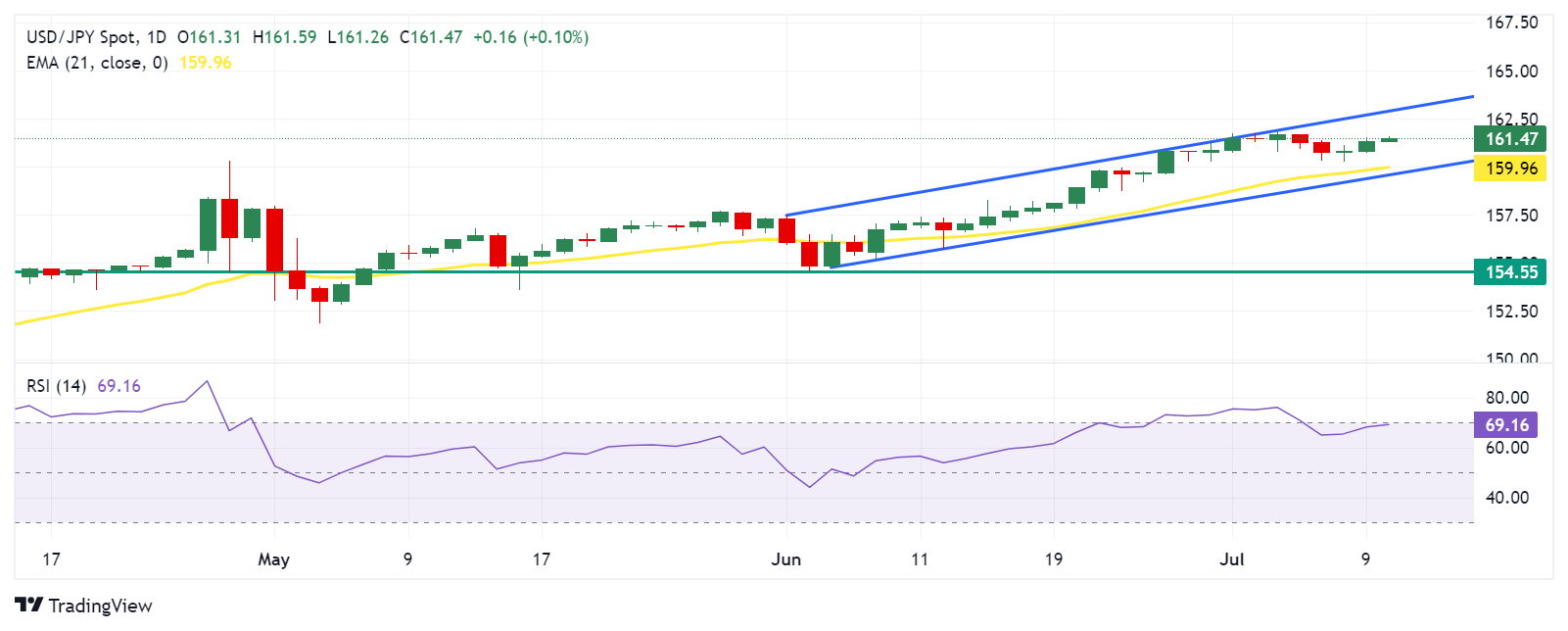- The Japanese Yen struggles as the US Dollar gains momentum following Fed Chair Jerome Powell’s testimony on Tuesday.
- The Bank of Japan is set to assess a viable strategy to reduce its purchases of government bonds.
- Powell said a rate cut is not appropriate until the Fed gains confidence that inflation is headed toward 2%.
The Japanese Yen (JPY) is depreciating for the third consecutive session on Wednesday. The rise in the USD/JPY pair is driven by the strengthening of the US Dollar (USD), which gained momentum following Federal Reserve Chairman Jerome Powell’s testimony before the US Congress on Tuesday. Powell pointed to improved inflation figures but maintained the Fed’s cautious approach.
The Bank of Japan (BoJ) could raise interest rates at its July meeting and unveil plans to reduce its bond purchases. On Tuesday, Japanese Finance Minister Shunichi Suzuki stressed the importance of maintaining fiscal discipline to strengthen confidence in long-term fiscal health. Suzuki also mentioned that he will closely monitor discussions at the BoJ meeting on the bond market, Reuters reported.
Traders are anticipating several key events in financial markets. These include the second semi-annual testimony by Fed Chair Jerome Powell, speeches by Fed officials Michelle Bowman and Austan Goolsbee, and the release of US Consumer Price Index (CPI) data scheduled for Thursday.
Daily Market Wrap: Japanese Yen Falls on Fed’s Powell’s Hardline Stance
- Japan’s Producer Price Index (YoY) rose 2.9% in June, accelerating from an upwardly revised 2.6% increase in the previous month, in line with market expectations. This marks the 41st consecutive month of rising producer inflation and represents the highest level since August 2023.
- Fed Chairman Jerome Powell said in testimony before Congress on Tuesday: “More good data would strengthen our confidence in inflation.” Powell stressed that “a policy rate cut is not appropriate until the Fed gains greater confidence that inflation is sustainably headed toward 2%.” He also noted that “first quarter data did not support the increased confidence in the path of inflation that the Fed needs to cut rates.”
- According to a Bloomberg report on Tuesday, the Bank of Japan is holding three face-to-face meetings with banks, securities firms and financial institutions in the coming days. The purpose of these meetings is to assess a feasible pace for reducing its purchases of Japanese Government Bonds.
- The Japanese Yen is struggling due to purchases of overseas assets by Japanese individuals through the recently revamped tax-free investment scheme, the Nippon Individual Savings Account (NISA) program. According to Nikkei Asia, the scale of these purchases is expected to exceed the country’s trade deficit during the first half of this year.
- Japan’s Finance Ministry said Monday that Japanese investment fund management companies and asset management firms bought 6.16 trillion yen ($38 billion) more in overseas stocks and mutual fund shares than they sold during the first six months of the year.
- On Monday, the Bank of Japan (BoJ) maintained its economic assessment for five of Japan’s nine regions in its latest ‘Sakura Report’. The assessment for two regions was raised, while it was lowered for two other regions in the report released on Monday. As for price trends, the BoJ noted that many regions are reporting wage increases that are spreading among smaller firms.
Technical Analysis: USD/JPY rises near 161.50
USD/JPY is trading around 161.50 on Wednesday. The pair maintains its upward trajectory within an ascending channel pattern, which suggests a bullish bias according to the daily chart analysis. Adding to this bullish outlook, the 14-day Relative Strength Index (RSI) is holding above the 50 level, reinforcing the strength of the uptrend.
Looking ahead, the USD/JPY pair could target a critical resistance level near 162.70, located at the upper boundary of the ascending channel. A successful break above this level could strengthen the bullish sentiment, potentially propelling the pair towards the psychological resistance at 163.00.
On the downside, initial support for the USD/JPY pair is anticipated around the 21-day exponential moving average (EMA) at 159.96. A break below this level could exert pressure, leading to a test of the lower boundary of the ascending channel around 159.60. A further drop below this channel support could take the pair towards the vicinity of the June low at 154.55.
USD/JPY: Daily Chart
Japanese Yen PRICE Today
The table below shows the Japanese Yen (JPY) exchange rate against major currencies today. The Japanese Yen was the weakest currency against the British Pound.
| USD | EUR | GBP | JPY | CAD | AUD | NZD | CHF | |
|---|---|---|---|---|---|---|---|---|
| USD | -0.06% | -0.08% | 0.08% | -0.06% | -0.05% | 0.59% | -0.02% | |
| EUR | 0.06% | 0.00% | 0.14% | 0.02% | 0.00% | 0.63% | 0.03% | |
| GBP | 0.08% | -0.01% | 0.14% | 0.02% | -0.01% | 0.62% | 0.01% | |
| JPY | -0.08% | -0.14% | -0.14% | -0.12% | -0.14% | 0.45% | -0.14% | |
| CAD | 0.06% | -0.02% | -0.02% | 0.12% | 0.00% | 0.62% | -0.00% | |
| AUD | 0.05% | -0.00% | 0.00% | 0.14% | 0.00% | 0.62% | 0.00% | |
| NZD | -0.59% | -0.63% | -0.62% | -0.45% | -0.62% | -0.62% | -0.61% | |
| CHF | 0.02% | -0.03% | -0.01% | 0.14% | 0.00% | -0.00% | 0.61% |
The heatmap shows percentage changes of major currencies. The base currency is selected from the left column, while the quote currency is selected from the top row. For example, if you choose the Japanese Yen from the left column and move along the horizontal line to the US Dollar, the percentage change shown in the chart will represent the JPY (base)/USD (quote).
Bank of Japan FAQs
The Bank of Japan (BoJ) is the Japanese central bank, which sets the country’s monetary policy. Its mandate is to issue banknotes and carry out monetary and foreign exchange control to ensure price stability, which means an inflation target of around 2%.
The Bank of Japan has been pursuing ultra-loose monetary policy since 2013 in order to stimulate the economy and fuel inflation amid a low-inflation environment. The bank’s policy is based on Quantitative and Qualitative Easing (QQE), or printing money to buy assets such as government or corporate bonds to provide liquidity. In 2016, the bank doubled down on its strategy and further relaxed policy by first introducing negative interest rates and then directly controlling the yield on its 10-year government bonds.
The Bank of Japan’s massive stimulus has caused the Yen to depreciate against its major currency peers. This process has been exacerbated more recently by a growing policy divergence between the Bank of Japan and other major central banks, which have opted to sharply raise interest rates to combat decades-high inflation. The Bank of Japan’s policy of keeping rates low has led to a widening spread with other currencies, dragging down the value of the Yen.
The weak yen and the surge in global energy prices have caused Japanese inflation to rise, exceeding the Bank of Japan’s 2% target. However, the Bank of Japan believes that a sustainable and stable achievement of the 2% target is not yet in sight, so a sharp change in current monetary policy seems unlikely.
Source: Fx Street
I am Joshua Winder, a senior-level journalist and editor at World Stock Market. I specialize in covering news related to the stock market and economic trends. With more than 8 years of experience in this field, I have become an expert in financial reporting.








